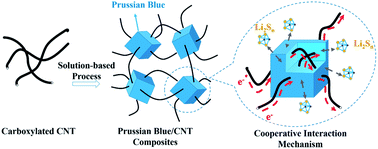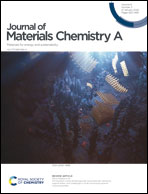Constructing a 3D compact sulfur host based on carbon-nanotube threaded defective Prussian blue nanocrystals for high performance lithium–sulfur batteries†
Abstract
Towards practical lithium–sulfur batteries, the rational design of a sulfur host that enables highly efficient sulfur electrochemistry and high areal sulfur loading is essential but still a challenge. Here, a class of 3D nanocomposite architecture characterised by a necklace-like structure that contains intertwined carbon-nanotubes (CNTs) and defective Prussian blue (PB) nanocrystals is developed as the sulfur host. Benefiting from the fact that a 3D CNT conductive skeleton can provide efficient ion/electron channels and the abundant Lewis acidic sites in PB can effectively entrap lithium polysulfide (LiPS) species, the S@PB/CNT composite cathode exhibits high reversibility, stable cycling performance, and fast kinetics. More importantly, the LiPS adsorption capacity of PB materials and the kinetics of LiPS conversion on PB is highly dependent on the amount of [Fe(CN)6] vacancies based on both theoretical and experimental studies, which may further shed light on the interfacial phenomena between the PB sulfur host and soluble LiPS in the electrolyte.

- This article is part of the themed collection: Journal of Materials Chemistry A HOT Papers


 Please wait while we load your content...
Please wait while we load your content...